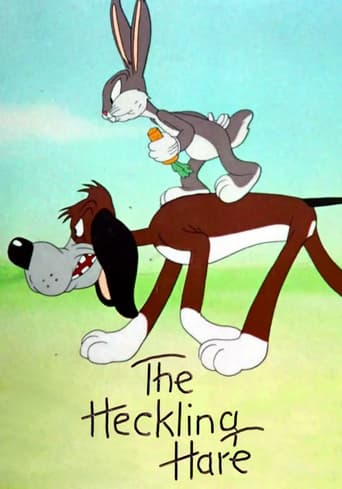Michael_Elliott
Heckling Hare, The (1941) *** (out of 4) The hunting dog Willoughby is out sniffing for a rabbit and of course finds Bugs Bunny but soon he's going to wish he hadn't. This is another winning short from director Avery who apparently walked away from Warner after a falling out due to the ending here. I certainly don't know all of the details but I did find the ending here to be the best thing about the movie, although one could argue the actual payoff is a tad bit of a cheat. The rest of the film isn't among Avery's best work but I think it's still a good film. Both Bugs and Willoughby work well together and there are plenty of funny scenes including the before mentioned ending as well as another scene where the dog thinks he has killed bugs.
slymusic
Directed by Tex Avery, "The Heckling Hare" is a wildly funny Bugs Bunny cartoon featuring some terrific animation. The term "wascawwy wabbit" doesn't even begin to describe Bugs as he takes advantage of a dopey canine who tries to track him down.My favorite moments from "The Heckling Hare" include the following (DON'T read any further if you have not yet seen this cartoon). The best and most memorable sequence in this film is the lengthy, hilarious fall off the cliff (which, by the way, was the cause of some seriously bad blood between producer Leon Schlesinger and Tex Avery, who decided to part ways with Warner Bros. and move on to the cartoon studio at MGM). Bugs does his nonchalant "Strollin' Thru the Park One Day" walk with a carrot jutting from his mouth, after which he and the dog exchange a myriad of funny faces, ending with Bugs applying a baseball bat to the dog's head. And when the dog chases Bugs underwater, Bugs' ears incongruously circle around a tree stump! "The Heckling Hare" is one of those Bugs Bunny cartoons you just gotta see! Catch it on the Looney Tunes Golden Collection Volume 2 Disc 1.
ccthemovieman-1
After watching a bunch of 1950s Bugs Bunny cartoons, it was shock to see him in this early 1941 effort. He looks different, with a more oblong shaped head (glad they changed that) and the artwork looks different (no complaints in that department with the nice watercolors- type look). The next thing I noticed was Bugs' voice. Even though it was the same Mel Blanc doing Bugs, the voice was deeper. Frankly, it didn't right, probably because most of us aren't used to seeing him and hearing him like this.The story is one that was shown many times afterward except hunter Elmer Fudd was playing the role that a dog did in here, namely going after Bugs and the latter outsmarting him at every turn. The two animals making faces at one another was good, as were a few other comedy bits involving Bugs' ears or the dog's tail. Bugs' rhetorical question sums it up best: "Let's see; what can I do to this guy now?" Overall, a fair effort. I think these were better-written in the '50s, and what's with all the kissing? That's overdone.
catradhtem
Tex Avery finally follows up 1940's "A Wild Hare" with a worthy sequel, in which a hunting dog is sniffing for some rabbit and comes upon a certain wabbit hole.After seeing him in four previous films, the audience has become more familiar with Bugs, so Bugs naturally starts to confide in them with glances and asides ("What can I do t'dis guy next?"). It works better than when Cecil Turtle did the same kind of thing in the previous "Tortoise Beats Hare." We don't know this little green lizard...why should we trust him? Bugs, on the other hand, we know by now is all right...and we can definitely trust him.Not to say that Bugs isn't sugar and spice, of course. He still has a cocky streak to him, and at the end of the picture even sasses the audience. Could Bugs be the first animated hero that shows contempt for the people rooting for him?Mike Maltese introduces some great gags in this story, and it's only a shame that he didn't work on any more Bugs cartoons with Avery, as they could have come up with masterpieces.
